The content of the article
- 1 Types of laminate
- 2 Required tools
- 3 Important general requirements for laying laminate flooring
- 4 The process of laying the flooring with double locks ("click" -locks)
- 5 The process of laying the flooring with "lok" -locks
- 6 The process of laying adhesive laminated parquet
- 7 Auxiliary instruction
- 8 Video: how to lay laminate
Qualitatively put laminated parquet is considered one of the most difficult repair processes. Laying laminate needs constant monitoring and attention to detail. Compliance with simple requirements will help the floor to serve for a long time, and proper care will provide a beautiful aesthetic look for many years. You can put laminate on your own, without turning to professional craftsmen. The laying technique is not difficult when all the working moments are taken into account. Before starting work, it is necessary to carefully consider all types of laminate and choose the most suitable for technical characteristics.
Types of laminate
Laminated parquet is divided into two types of fasteners: adhesive and castle. Glue is fixed with glue and is simple to install. Castle type is divided into "click" fasteners and lok-fasteners. “Click” - professionals call locks double locks, which are extremely reliable. This type of fasteners is difficult to damage in the process of work and it creates a strong connection.
"Lock" -locks with spikes, on the contrary, the masters use very rarely, gradually abandoning them. It is difficult to create a stable connection, since the clutch of the plates is unstable, as a result of which the coating will not last for long. Nevertheless, the price of such a laminate is much lower than with double locks, but it is almost impossible to get a quality floor using it.
Required tools
Electric jigsaw, which serves for cutting out small or non-standard openings, such as doorways, a notch for radiator legs and other shaped objects.
- Wooden or silicone hammer for landing plates.
- A construction tape measure, a notebook for notes and a pencil will be irreplaceable.
- Blades to maintain a certain width of the gap between the wall and the coating
- Staples metal.
Important general requirements for laying laminate flooring
When installing not only laminate, but also any floor covering, you should be guided by the basic requirements and advice of craftsmen. One of these requirements is a flat floor surface without gouges and bumps. It is permissible to lay laminate on the old floor, be it linoleum or carpet. However, it is worth considering that the surface should be smooth - this rule has not been canceled. The coating is placed perpendicular to the window so that the rays of light go in the direction of the plates. In cases where this advice is neglected, the light emphasizes all the joints and flaws of the floor, which makes it difficult to create a beautiful aesthetic appearance. Many craftsmen use laminate stacking diagonally, but the technology itself is considered difficult for an untrained person and rarely justifies the effort.
Before starting the installation, measure the width of the room and, as a result, the width of the extreme plate of the row. You also need to know that the gap between the wall and the sheet of laminate should be about 1 cm in cases where the width of the room is less than 10 meters.If the room is more than 10 meters - the gap is calculated by the formula 1 meter multiplied by 1.5 cm. Do not neglect the size of the gap, making it smaller, because the coating tends to expand under the action of heat, pressure and other factors, resulting in mounds. In those cases when, when calculating the width of the extreme plate of a row, it turns out to be less than 5 cm, it is required to cut the first and last panels into the same width with a jigsaw. Laying the plate should be from the left angle in the direction of light, that is, perpendicular to the window. After the row is laid, blades are inserted between the wall and the covering, which are removed when the installation is completed.
The process of laying the flooring with double locks ("click" -locks)
The installation of the first plate always starts from the left corner of the front wall. The second panel joins the first side by inserting the lock into the groove at an angle of 30-40 degrees, then lowers to the floor, resulting in the locking of the locks. This scheme is valid during the installation of the series to the end. When the last panel is placed against the wall, you should use a metal bracket that will facilitate convenient tamping of the plate. Before proceeding to the second row, you need to move the end seams by 30 cm compared with the first row.This simple technique will evenly distribute the pressure on the floor during operation.
Laminated coating looks beautiful when the panels are arranged in a checkerboard pattern. To achieve this effect, it will be necessary to cut the panel into two equal parts, thereby starting the next row with one of them. There are two ways of laying the second row: you can connect the plates with the ends between each other, and then insert several panels fastened in one row into the grooves of the first row along the entire length. Actions are performed at an angle of 30-40 degrees, preventing creasing fasteners, after which the inserted row is lowered to the floor and the locks are connected. The following method involves connecting the long sides of the plate, and then mounting the end plates using a hammer. Applying the latest technique is useful piece of laminate, which will need to knock, putting to the end of the drive-in panel.
The process of laying the flooring with "lok" -locks
This type of lock is different from the previous connection process. The plates have peculiar protrusions or spikes from the end, which are inserted into the grooves of the next panel.The main requirement when laying this type of coating is a horizontal floor position. Panels are inserted using a hammer and a bar to provide a stable grip. Laying begins from the left corner of the front wall, the panels are attached to each other end side. The technique of chessboard is observed as well as when installing laminate with double locks. However, in the next row, the first plate is horizontally applied with a spike into the groove of the first row. The next panel of this row is connected to the first row in length and only then is inserted into the groove of the first plate of the second row with a hammer.
The process of laying adhesive laminated parquet
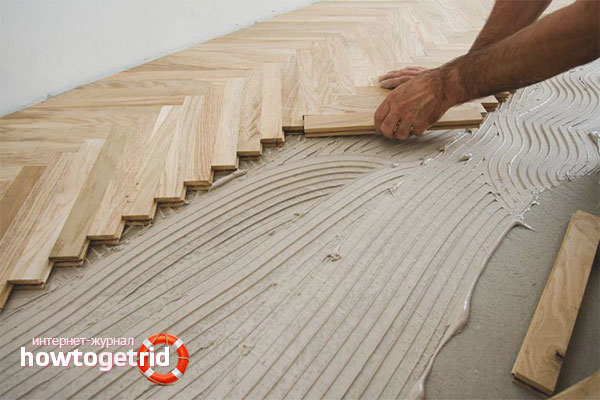
One of the most sophisticated technologies for laying a coating is the process of installing an adhesive laminate. This technology is good because the adhesive base provides durability and reliability of the adhesion of the plates to each other. Operation is allowed after twelve hours from the moment of installation. Installation of this type of coating requires caution and accuracy, since it will not be possible to disassemble and start over. It is forbidden to use glue in large quantities, you should fully adhere to the attached instructions.As for the process itself, it is identical to the installation, which is used for laying the coating with double fasteners. The only nuance of this technology is that the installation process takes a lot of time. You should also ensure that the glue from the seams does not fall on the product. Upon completion of the installation of laminated parquet, remove the blades from the gap. Next, the slot will cover the plinth, which must be fixed on the wall without fail.
Auxiliary instruction
- Trimming products that remain after sawing the plates can be used at the beginning and at the end of a row. In this case, the length of the trim should not be less than 30 cm.
- Leave the gaps in the doorways, along the walls, as well as in cases of joining laminate with a different coating.
- Blades from the gaps are allowed to remove immediately when installing the locking plates, however, when laying the adhesive coating - after the glue dries.
- It is allowed to install water-based underfloor heating under the laminated coating.
- Before starting work, remove all doors.
Video: how to lay laminate

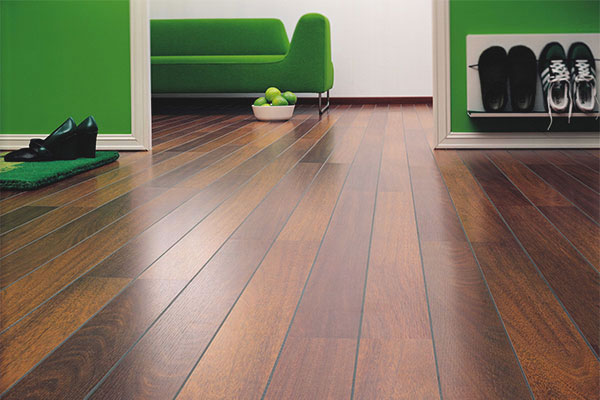
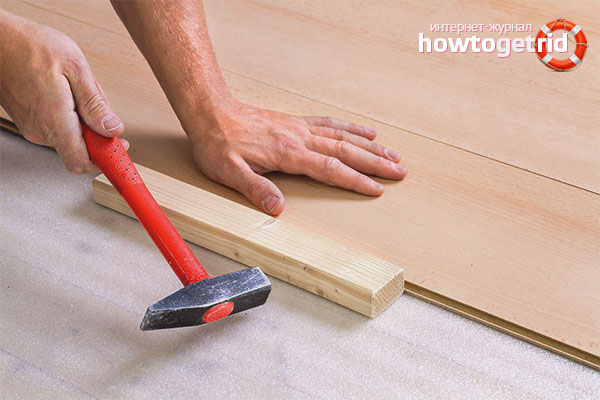
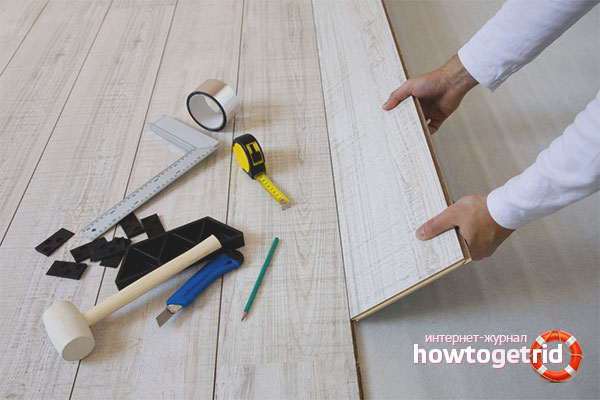








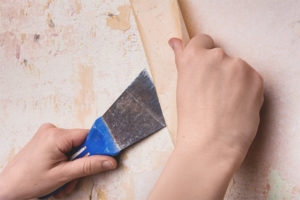
To send